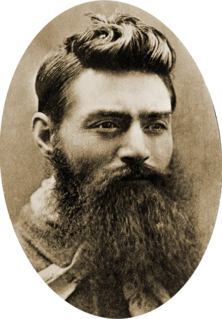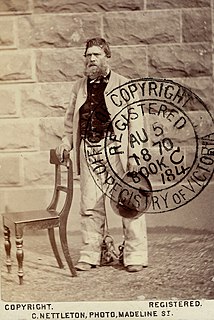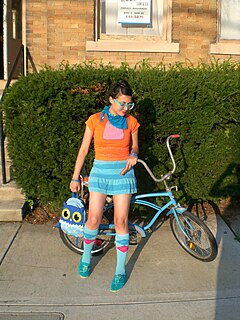
Bushrangers were originally escaped convicts in the early years of the British settlement of Australia who used the bush as a refuge to hide from the authorities. By the 1820s, the term had evolved to refer to those who took up "robbery under arms" as a way of life, using the bush as their base.

The Story of the Kelly Gang is a 1906 Australian bushranger film that traces the exploits of 19th-century bushranger and outlaw Ned Kelly and his gang. It was directed by Charles Tait and shot in and around the city of Melbourne. The original cut of this silent film ran for more than an hour with a reel length of about 1,200 metres (4,000 ft), making it the longest narrative film yet seen in the world. It premiered at Melbourne's Athenaeum Hall on 26 December 1906 and was first shown in the United Kingdom in January 1908. A commercial and critical success, it is regarded as the origin point of the bushranging drama, a genre that dominated the early years of Australian film production. Since its release, many other films have been made about the Kelly legend.

Edward "Ned" Kelly was an Australian bushranger, outlaw, gang leader and convicted police-murderer. One of the last bushrangers, he is known for wearing a suit of bulletproof armour during his final shootout with the police.

Glenrowan is a small town located in the Wangaratta local government area of Victoria, Australia. It is 236 kilometres north-east of Melbourne and 14 kilometres from Wangaratta and near the Warby Ranges and Mount Glenrowan. At the 2016 census, Glenrowan had a population of 963.

James Ross Bartel is a former Australian rules footballer who played for the Geelong Football Club in the Australian Football League (AFL). A utility, 1.87 m tall and weighing 89 kilograms (196 lb), Bartel was able to contribute as a midfielder, forward, or defender.

Henry Johnson, better known by his alias Harry Power, was an Irish-born convict who became a bushranger in Australia. From 1869 to 1870, he was accompanied by a young Ned Kelly, who went on to become Australia's best known bushranger.
"The Wild Colonial Boy" is a traditional anonymous Irish-Australian ballad which tells the story of a bushranger in early colonial Australia who dies during a gunfight with local police. Versions of the ballad give different names for the bushranger involved: some based on real individuals and some apparently fictional. A common theme is romanticisation of the bushranger's battle against colonial authority. The ballad's popularity over time has encouraged numerous re-recordings by twentieth century artists.
The following lists events that happened during 1880 in Australia.

John Dunn was an Australian bushranger. He was born at Murrumburrah near Yass in New South Wales. He was 19 years old when he was hanged in Darlinghurst Gaol. He was buried in the former Devonshire Street Cemetery in Sydney.

St Joseph's College is an independent Catholic secondary school for boys, located in the inner Geelong suburb of Newtown, Victoria, Australia. The school was founded by the Congregation of Christian Brothers in 1935, who continue to run the school, and provides education from year 7–12, offering a broad range of curricular choices for its students in middle and senior schools including VCE, VET and VCAL.
The following lists events that happened during 1879 in Australia.
The following lists events that happened during 1854 in Australia.

The 21st-century hipster is a subculture. Fashion is one of the major markers of hipster identity. Members of the subculture typically do not self-identify as hipsters, and the word hipster is often used as a pejorative for someone who is pretentious or overly concerned with appearing trendy.
This article discusses the etymology of the word hippie.
Romanticised outlaws are stock characters found in a number of fictional settings.
When the Kellys Rode is a 1934 Australian film directed by Harry Southwell about Ned Kelly.

Australian Western, also known as Meat Pie Western or Kangaroo Western, is a broad genre of Western-style films or TV series set in the Australian outback or "the bush". Films about bushrangers are included in this genre. Some films categorised as meat-pie or Australian Westerns also fulfil the criteria for other genres, such as drama, revisionist Western, crime or thriller.
The bushranger ban refers to a ban on films about bushrangers that came in effect in Australia in 1911–12. Films about bushrangers had been the most popular genre of local films ever since The Story of the Kelly Gang (1906). Governments were worried about the influence this would have on the population and bans against films depicting bushrangers were introduced in South Australia (1911), New South Wales and Victoria (1912).

Ned Kelly is an Australian musical with book and lyrics by Reg Livermore and music by Patrick Flynn. It tells the story of Australian bushranger Ned Kelly with an eclectic score combining rock opera, vaudeville and burlesque. The original Australian production played in Adelaide and Sydney in 1977 and 1978.

True History of the Kelly Gang is a 2019 bushranger film directed by Justin Kurzel, written by Shaun Grant, and based upon the 2000 novel of the same name by Peter Carey. A fictionalised account of the life of bushranger and outlaw Ned Kelly, the film stars George MacKay, Essie Davis, Nicholas Hoult, Charlie Hunnam and Russell Crowe.












